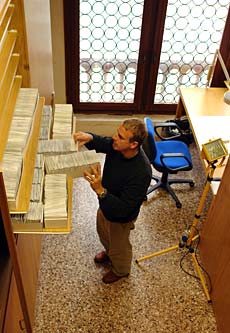
The image above accompanies a press release from Berkeley about research being done with a vast collection of fungi. Matteo Garbelotto (the fellow in the picture) is sifting through 28,000 samples housed at the Venice Museum of Natural History to create a database of fungal DNA.
I have previously belittled the use of scientist-at-work images, but I quite like this one, in large part because it represents an aspect of the scientific endeavor that doesn’t occur to most people. The sheer scope of this kind of collections-based research is familiar around the halls of my home institution, but I don’t think it occurs to the majority of people how much drudgery goes into a lot of research. And how, sometimes, you just have to flip through things the good old-fashioned way.
That said, it would have been nice to complement the images with a high-tech DNA something-or-other, just to illustrate the contrast between 19th-century card catalogs of fungi and 21st-century methods of analysis.
I also have to note, admitting my typical ignorance of most science biological, that I had no idea of the role played by fungi until I read Michael Pollan’s brilliant Omnivore’s Dilemma. As the Wikipedia article on fungi notes, “Fungi often have important symbiotic relationships with other organisms. Mycorrhizal symbiosis between plants and fungi is particularly important; over 90% of all plant species engage in some kind of mycorrhizal relationship with fungi and are dependent upon this relationship for survival.” Holy toadstool, Batman!
